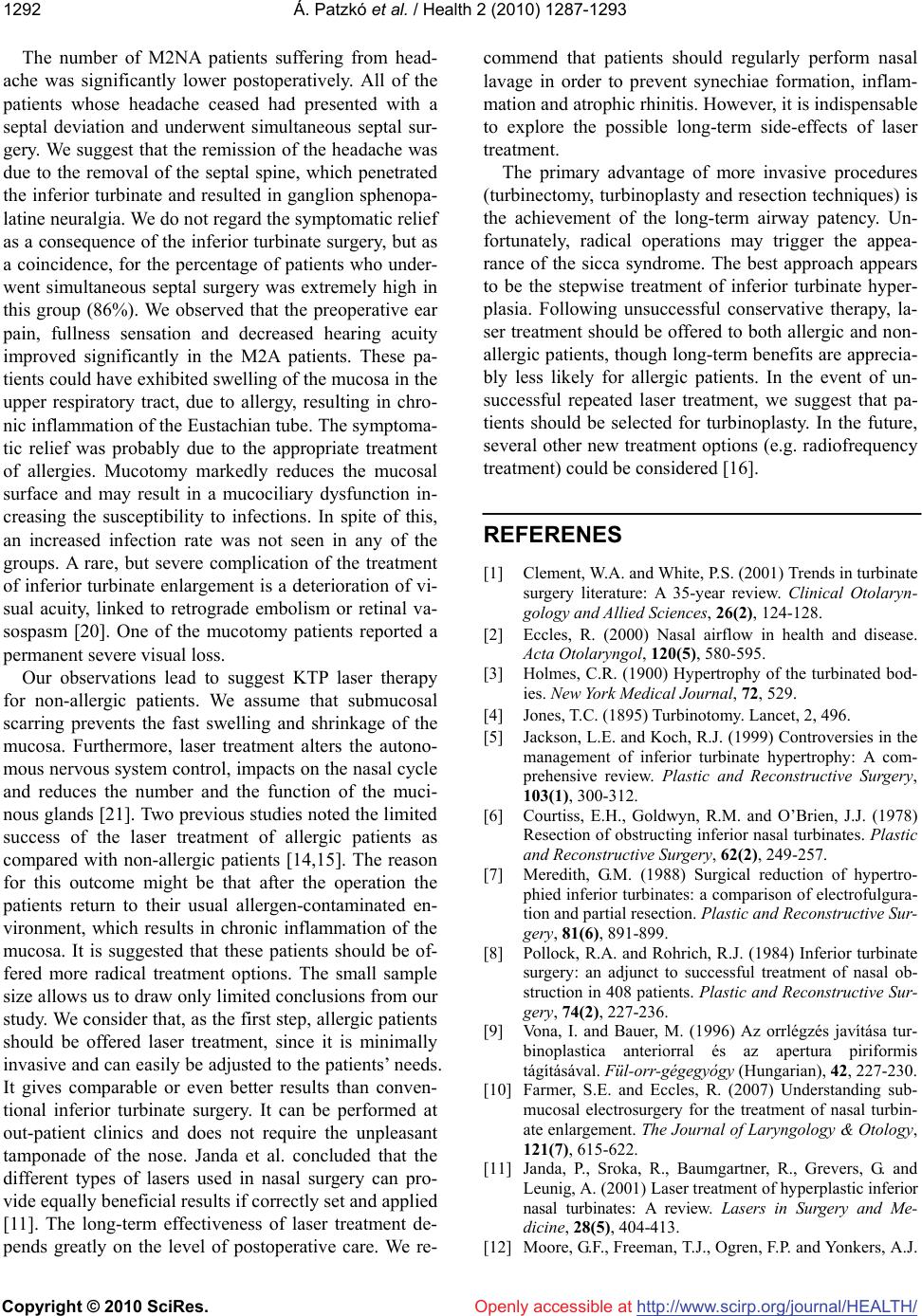
Á. Patzkó et al. / Health 2 (2010) 1287-1293
Copyright © 2010 SciRes. http://www.scirp.org/journal/HEALTH/
1292
Openly accessible at
The number of M2NA patients suffering from head-
ache was significantly lower postoperatively. All of the
patients whose headache ceased had presented with a
septal deviation and underwent simultaneous septal sur-
gery. We suggest that the remission of the headache was
due to the removal of the septal spine, which penetrated
the inferior turbinate and resulted in ganglion sphenopa-
latine neuralgia. We do not regard the symptomatic relief
as a consequence of the inferior turbinate surgery, but as
a coincidence, for the percentage of patients who under-
went simultaneous septal surgery was extremely high in
this group (86%). We observed that the preoperative ear
pain, fullness sensation and decreased hearing acuity
improved significantly in the M2A patients. These pa-
tients could have exhibited swelling of the mucosa in the
upper respiratory tract, due to allergy, resulting in chro-
nic inflammation of the Eustachian tube. The symptoma-
tic relief was probably due to the appropriate treatment
of allergies. Mucotomy markedly reduces the mucosal
surface and may result in a mucociliary dysfunction in-
creasing the susceptibility to infections. In spite of this,
an increased infection rate was not seen in any of the
groups. A rare, but severe complication of the treatment
of inferior turbinate enlargement is a deterioration of vi-
sual acuity, linked to retrograde embolism or retinal va-
sospasm [20]. One of the mucotomy patients reported a
permanent severe visual loss.
Our observations lead to suggest KTP laser therapy
for non-allergic patients. We assume that submucosal
scarring prevents the fast swelling and shrinkage of the
mucosa. Furthermore, laser treatment alters the autono-
mous nervous system control, impacts on the nasal cycle
and reduces the number and the function of the muci-
nous glands [21]. Two previous studies noted the limited
success of the laser treatment of allergic patients as
compared with non-allergic patients [14,15]. The reason
for this outcome might be that after the operation the
patients return to their usual allergen-contaminated en-
vironment, which results in chronic inflammation of the
mucosa. It is suggested that these patients should be of-
fered more radical treatment options. The small sample
size allows us to draw only limited conclusions from our
study. We consider that, as the first step, allergic patients
should be offered laser treatment, since it is minimally
invasive and can easily be adjusted to the patients’ needs.
It gives comparable or even better results than conven-
tional inferior turbinate surgery. It can be performed at
out-patient clinics and does not require the unpleasant
tamponade of the nose. Janda et al. concluded that the
different types of lasers used in nasal surgery can pro-
vide equally beneficial results if correctly set and applied
[11]. The long-term effectiveness of laser treatment de-
pends greatly on the level of postoperative care. We re-
commend that patients should regularly perform nasal
lavage in order to prevent synechiae formation, inflam-
mation and atrophic rhinitis. However, it is indispensable
to explore the possible long-term side-effects of laser
treatment.
The primary advantage of more invasive procedures
(turbinectomy, turbinoplasty and resection techniques) is
the achievement of the long-term airway patency. Un-
fortunately, radical operations may trigger the appea-
rance of the sicca syndrome. The best approach appears
to be the stepwise treatment of inferior turbinate hyper-
plasia. Following unsuccessful conservative therapy, la-
ser treatment should be offered to both allergic and non-
allergic patients, though long-term benefits are apprecia-
bly less likely for allergic patients. In the event of un-
successful repeated laser treatment, we suggest that pa-
tients should be selected for turbinoplasty. In the future,
several other new treatment options (e.g. radiofrequency
treatment) could be considered [16].
REFERENES
[1] Clement, W.A. and White, P.S. (2001) Trends in turbinate
surgery literature: A 35-year review. Clinical Otolaryn-
gology and Allied Sciences, 26(2), 124-128.
[2] Eccles, R. (2000) Nasal airflow in health and disease.
Acta Otolaryngol, 120(5), 580-595.
[3] Holmes, C.R. (1900) Hypertrophy of the turbinated bod-
ies. New York Medical Journal, 72, 529.
[4] Jones, T.C. (1895) Turbinotomy. Lancet, 2, 496.
[5] Jackson, L.E. and Koch, R.J. (1999) Controversies in the
management of inferior turbinate hypertrophy: A com-
prehensive review. Plastic and Reconstructive Surgery,
103(1), 300-312.
[6] Courtiss, E.H., Goldwyn, R.M. and O’Brien, J.J. (1978)
Resection of obstructing inferior nasal turbinates. Plastic
and Reconstructive Surgery, 62(2), 249-257.
[7] Meredith, G.M. (1988) Surgical reduction of hypertro-
phied inferior turbinates: a comparison of electrofulgura-
tion and partial resection. Plastic and Reconstructive Sur-
gery, 81(6), 891-899.
[8] Pollock, R.A. and Rohrich, R.J. (1984) Inferior turbinate
surgery: an adjunct to successful treatment of nasal ob-
struction in 408 patients. Plastic and Reconstructive Sur-
gery, 74(2), 227-236.
[9] Vona, I. and Bauer, M. (1996) Az orrlégzés javítása tur-
binoplastica anteriorral és az apertura piriformis
tágításával. Fül-orr-gégegyógy (Hungarian), 42, 227-230.
[10] Farmer, S.E. and Eccles, R. (2007) Understanding sub-
mucosal electrosurgery for the treatment of nasal turbin-
ate enlargement. The Journal of Laryngology & Otology,
121(7), 615-622.
[11] Janda, P., Sroka, R., Baumgartner, R., Grevers, G. and
Leunig, A. (2001) Laser treatment of hyperplastic inferior
nasal turbinates: A review. Lasers in Surgery and Me-
dicine, 28(5), 404-413.
[12] Moore, G.F., Freeman, T.J., Ogren, F.P. and Yonkers, A.J.